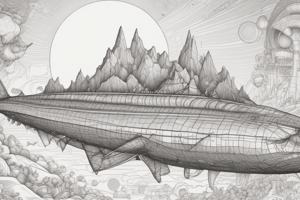Podcast
Questions and Answers
What is the primary tool used for making scientific drawings?
What is the primary tool used for making scientific drawings?
- Pencil (correct)
- Sharpener
- Eraser
- Ruler
What type of lines are used to draw specimens with fuzzy edges?
What type of lines are used to draw specimens with fuzzy edges?
- Smooth lines
- Unbroken lines
- Broken lines (correct)
- Curved lines
What is the purpose of shading in scientific drawings?
What is the purpose of shading in scientific drawings?
- To add color to the drawing
- To highlight important features
- To create a 3D effect
- There is no shading in scientific drawings (correct)
What is the term for creating an image using small dots?
What is the term for creating an image using small dots?
What is the purpose of using symbols in scientific drawings?
What is the purpose of using symbols in scientific drawings?
Flashcards are hidden until you start studying
Study Notes
Making Scientific Drawings
- Scientific drawings should be as simple as possible.
- Pencil is the preferred medium, and coloured pencils can be used.
- A ruler, eraser, and sharpener are necessary tools.
- Different pencil techniques are used to draw various objects:
Natural Objects
- Smooth-edged specimens are drawn using smooth, unbroken lines.
- Fuzzy-edged specimens (e.g. wool, cotton, or hair) are drawn using underlying structures with broken lines.
- No shading is used in scientific drawings.
Other Techniques
- Stippling (dotting) is used to create an effect.
- Streaking (lines in one direction) is used to create a pattern.
- Cross-hatching (lines crossing each other) is used to create depth and texture.
Symbols in Drawings
- Symbols can be used in scientific drawings if their meaning is clearly explained.
Examples of Drawing Techniques
- FIG 1.12 illustrates various drawing techniques used in science.
Studying That Suits You
Use AI to generate personalized quizzes and flashcards to suit your learning preferences.




